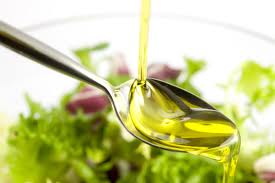Here
we provide you information and some details about Greek Olive varieties, as
follows:
VARIETY: ADRAMITIANI
ORIGIN: GREECE (LESVOS
island)
CORE: Middle
USE: Oil
COMMENTS: -
VARIETY: ATHINOLIA
ORIGIN: GREECE (Attica
& Lakonia)
CORE: Small
USE: Oil
COMMENTS: -
VARIETY: AMFISSAS
ORIGIN: GREECE
(Fokida)
CORE: Large
USE: Table
COMMENTS: -
VARIETY: ARACHOVAS
ORIGIN: GREECE
(Viotia)
CORE: Small
USE: -
COMMENTS: -
VARIETY: ASPROLIA
ORIGIN: GREECE (Corfu,
Lakonia, Lefkada)
CORE: Small
USE: -
COMMENTS: -
VARIETY: DAFNOLIA
ORIGIN: GREECE (Samos
island, Kyklades islands)
CORE: Middle
USE: -
COMMENTS: -
VARIETY: DAFNOMILIA
ORIGIN: GREECE
(Dodekanisa islands)
CORE: Middle
USE: -
COMMENTS: -
VARIETY: THROUBOLIA
ORIGIN: GREECE
(Dodekanisa islands, Evia, Iraklio & Rethymno Crete, Kavala, Kiklades
islands, Lesvos Island)
CORE: Middle
USE: -
COMMENTS: -
VARIETY: THIAKO
ORIGIN: GREECE (Ithaka
island, Kefalonia island)
CORE: Small
USE: -
COMMENTS: -
VARIETY: CORFU
LIANOLIA
ORIGIN: GREECE (Corfu)
CORE: Small
USE: -
COMMENTS: -
VARIETY: KORONEIKI
ORIGIN: GREECE (Attiki,
Etoloakarnania, Arkadia, Achaia, Zakinthos island, Ilia, Kefalonia island,
Korinthos, Lakonia, Messinia, Rethymno Crete, Fokida)
CORE: Small
USE: Oil
COMMENTS: -
VARIETY: KOTHREIKI
ORIGIN: GREECE
(Attiki, Viotia, Fokida)
CORE: Middle
USE: Oil
COMMENTS: -
VARIETY: KOLOVI
ORIGIN: GREECE (Lesvos
Island)
CORE: Middle
USE: Oil - Table
COMMENTS: -
VARIETY: KOUTSOURELIA
ORIGIN: GREECE
(Etoloakarnania)
CORE: Small
USE: Oil - Table
COMMENTS: -
VARIETY: MEGARA’s
LADOLIA
ORIGIN: GREECE
(Attiki)
CORE: Middle
USE: Oil
COMMENTS: -
VARIETY: MARONIA’s
LADOLIA
ORIGIN: GREECE
(Rodopi)
CORE: Middle
USE: Oil
COMMENTS: -
VARIETY: LADOLIA
ORIGIN: GREECE
(Argolida, Attiki, Thesprotia)
CORE: Middle
USE: Oil
COMMENTS: -
VARIETY: LIANILIA /
KRANEOMORFI
ORIGIN: GREECE
(Preveza)
CORE: Small
USE: Oil
COMMENTS: -
VARIETY: LIANOLIA
ORIGIN: GREECE
(Dodekanisa Islands, Zakinthos Island, Crete, Kefalonia Island)
CORE: Small
USE: Oil
COMMENTS: -
VARIETY: TRIGLIA’s
MAKROLIA
ORIGIN: GREECE (Evros)
CORE: Large
USE: Oil
COMMENTS: -
VARIETY: MANAKOLIA
ORIGIN: GREECE (Arkadia)
CORE: Small
USE: Oil
COMMENTS: -
VARIETY: MANAKILIA
ORIGIN: GREECE
(Korinthos)
CORE: Middle
USE: Oil
COMMENTS: -
VARIETY: MATSOLIA
ORIGIN: GREECE
(Arkadia, Ilia, Messinia)
CORE: Small
USE: Oil
COMMENTS: -
VARIETY: MAVROLIA
ORIGIN: GREECE (Corfu
Island, Lefkada Island, Messinia)
CORE: Small
USE: Oil, table
COMMENTS: -
VARIETY: MANAKI /
MANOLIA
ORIGIN: GREECE (Argolida)
CORE: Middle
USE: Oil - Table
COMMENTS: -
VARIETY: MOURTOLIA
ORIGIN: GREECE
(Lakonia)
CORE: Middle
USE: Oil
COMMENTS: -
VARIETY: MEGARITIKI
ORIGIN: GREECE
(Attiki, Viotia, Arkadia, Korinthos)
CORE: Middle
USE: Oil - Table
COMMENTS: -
VARIETY: PATRINOLIA
ORIGIN: GREECE
(Achaia)
CORE: Middle
USE: Oil
COMMENTS: -
VARIETY: SAMOTHRAKIS
ORIGIN: GREECE (Evros)
CORE: Large
USE: Table
COMMENTS: -
VARIETY: SALONITIKI
ORIGIN: GREECE
(Viotia)
CORE: Middle
USE: -
COMMENTS: -
VARIETY: STRAVOMITA
ORIGIN: GREECE
(Fokida)
CORE: Large
USE: -
COMMENTS: -
VARIETY: TSOUNATI
ORIGIN: GREECE (Chania
& Rethymno Crete)
CORE: Small
USE: Oil
COMMENTS: -
VARIETY: CHONDROLIA
(L)
ORIGIN: GREECE (Etoloakarnania,
Arta, Evia, Magnisia, Samos Island, Fthiotida, Chalkidiki, Iraklio &
Rethymno – Crete)
CORE: Large
USE: Table
COMMENTS: -
VARIETY: CHONDROLIA (M)
ORIGIN: GREECE
(Etoloakarnania, Arta, Evia, Thesprotia, Magnisia, Samos Island, Fthiotida,
Chalkidiki, Rethymno-Crete)
CORE: Middle
USE: Oil
COMMENTS: -
VARIETY: CHOURMADOLIA
ORIGIN: GREECE (Chios
Island)
CORE: Middle
USE: Oil - Table
COMMENTS: -
VARIETY: AMIGDALOLIA
ORIGIN: GREECE
(Attiki, Fokida)
CORE: -
USE: -
COMMENTS: -
VARIETY: KALAMON
ORIGIN: GREECE
(Messinia, Lakonia, Lamia)
CORE: Middle
USE: Oil - Table
COMMENTS: -
VARIETY: KONSERVOLIA
ORIGIN: GREECE
(Amfissa, Volos, Evia)
CORE: Middle
USE: Oil - Table
COMMENTS: -
VARIETY: MASTOIDIS
ORIGIN: GREECE (Corfu
Island, Crete, Peloponnese)
CORE: Middle
USE: Oil - Table
COMMENTS: -
VARIETY: VALANOLIA
ORIGIN: GREECE (Lesvos
Island, Skyros Island, Chios Island)
CORE: Small
USE: Oil
COMMENTS: -















